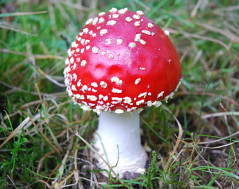
Not one for the pot - poisonous fungi
These are a valuable natural food resource for recreational and commercial collectors, but also for a range of wildlife.
Mushroom gathering has been steadily increasing in Scotland in recent years, with a growth of TV programmes and books on wild cookery and following people moving from other European countries which may have a stronger tradition of wild foraging. In response Scottish Natural Heritage (SNH) is urging collectors to follow the Scottish Wild Mushroom Code. The organisation says following the Code makes it possible to collect fungi in a responsible way, allowing more people to enjoy the various species to hand.
SNH says there are also several commercial companies which supply high quality restaurants, and export to London and France. Turnover can be as much as £5 to £6million per year.
The favoured commercial species are chanterelle, ceps and wood hedgehogs, but the value of fungi in our woodlands goes far and beyond their gourmet qualities.
Mycologist Nev Kilkenny explained: “Fungi are really crucial in the living world. Ninety per cent of all plants depend on fungi to help them access minerals and water, and they also help recycle dead plants, relaesing nutrients back into the soil.
“They also provide vital food and homes to other forms of life – for instance the dryad’s saddle, a bracket fungus which appears in the late spring, is associated with 98 different types of beetle.”
The code was drawn up some years ago by a forum of conservation organisations, public and private landowners, and mushroom buyers and pickers to encourage the sustainable use of the resource.
It has recently been reviewed and contains useful advice on collecting, such as always waiting until the cap has opened before picking to allow release of spores, and avoiding trampling which can damage the sensitive fungal threads underground.
Woodlands around Strathspey and the Cairngorms National Park can be particularly rich with autumn fungi, and Keith Duncan of Scottish Natural Heritage (SNH) encourages people to follow the advice in the code.
“Fungi are an essential ingredient in a healthy environment, and if you are collecting fungi for commercial purposes please make contact with landowners beforehand,” he said.
“They can be really beautiful features amidst the fantastic autumn colours of our native woodlands and give a real visual treat for people visiting the outdoors.”
You can download a copy of Code here.
